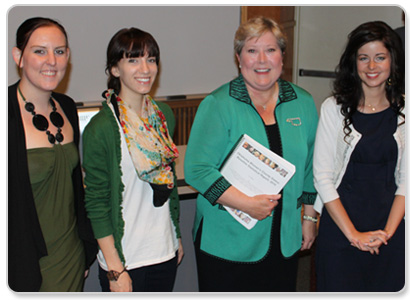OSU students complete 2010 report on the status of Oklahoma women, present findings to Lt. Governor and state commission
Thursday, April 29, 2010
Oklahoma State University students and their professor teamed up with The Oklahoma
Commission on the Status of Women and the Women’s Archives at the OSU Library to produce
a comprehensive statistical profile of the status of women in each of Oklahoma’s 77
counties. “Oklahoma Women’s County Status: Baseline Statistical Report, 2010” was
given to Lt. Governor Jari Askins when she visited the OSU campus in Stillwater Thursday
to meet with the students and is being officially released to the commission during
its Incarceration of Oklahoma Women Solutions Initiative Summit Friday from 8:30 a.m.
– 2 p.m. at the Oklahoma National Guard Training Institute located at 63rd & Kelly
in Oklahoma City.
“I am proud to see these students putting forth such time and effort; the findings
of this report could very well affect future legislation and policy. It is important
to continually evaluate the status of women in this state so we can do everything
possible to make improvements,” said Lt. Governor Askins.
This report is one of a number of collaborative endeavors between OSU and the Commission
on the Status of Women in recent years.
“This 244-page report looks at sixty-one indicators in seven areas,” said OSU Regents
Professor Bob Darcy. “The indicators include demographics, politics, economic participation,
social autonomy, pregnancy, health and criminal justice.”
The report also includes 61 tables and 61 maps documenting each county’s status with
color codes for high and low values. Accompanying the tables and maps are narratives
relating national and Oklahoma trends, rankings showing how Oklahoma compares to other
states, and links to state and national government websites plus links to other organizations
for further information. In addition, an appendix explains exactly how the data
was obtained and crafted into the tables and maps.
The report was prepared by 40 women & politics students over the course of two semesters
and a geography freshman, Andrew Potter, created the maps over several months.
“Working on this project increased my knowledge of Oklahoma women, and women throughout
the United States,” Brooke Feachen, an OSU Journalism and Broadcasting senior, said.
“It was nice to work with real world issues instead of hypothetical scenarios. Walking
away with tangible results was well worth the hard work each of us put in.”
Katie Kautz, junior Political Science major from Mustang said “Working on this project
has given me a greater insight into the status of women in Oklahoma relative to the
nation as a whole. While in some areas we are doing okay, it was eye opening to see
the obvious need for improvement across the board. Clearly, we still have a long way
to go, but I don't think that the obstacles are insurmountable.”
Jennifer Paustenbaugh, Director of the Women’s Archives at the OSU Library, past
Commission chair and consultant on the project, said, “The opportunity to partner
with the Commission to provide baseline data on how women are faring around Oklahoma
is an important first step in addressing issues critical to the future of our great
state. We look forward to working with the legislature, government agencies, nonprofit
groups and others to improve the quality of life for Oklahoma women and girls.”
A very limited number of copies are available from the Oklahoma Commission on the
Status of Women. The entire report can be accessed at http://women.library.okstate.edu
or by linking to the Commission website at http://www.ok.gov/ocsw/.

